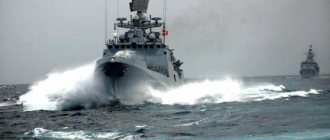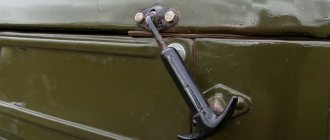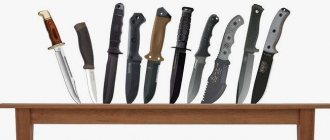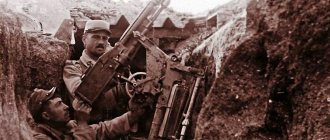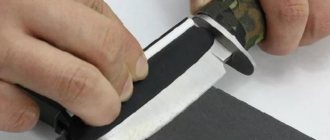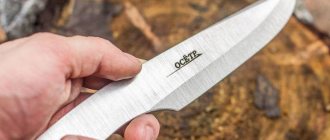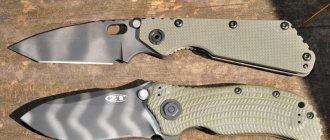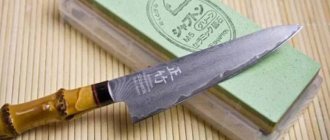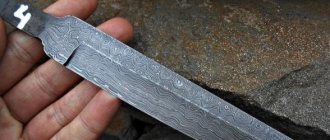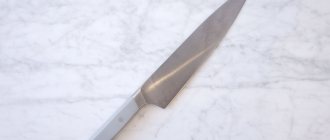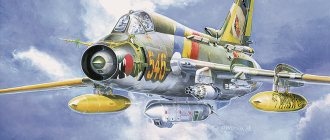Since ancient times, as soon as man learned to melt metal, knives appeared. They were used for hunting, living and killing their own kind. We can all see how household knives have changed; they are becoming lighter, softer, and made from soft metals, plastic, and ceramics. There is no guard, the handle is thin and plastic, the blade is made with teeth so as not to cut, but to tear. Hunting knives have a larger mass and a wider blade so that they can chop small branches and skin animal carcasses. How were combat knives created, what are the requirements for them, what alloys and technologies are used to create them? I've always wondered if combat knives really cut wire and never get dull. The Anti-Terror and Punisher knives are capable of this and even more.
What is a combat knife
A combat knife is a weapon officially adopted by the army or special forces. Its main goal is to defeat enemy personnel. They come in different shapes, weights and sharpening. If a knife is sharpened on one side, it means it is designed mainly for stabbing.
The basic requirements for combat knives can be summarized in several points. There is a joke that a man feels when he gets a real weapon in his hands, because he immediately wants to kill!
A combat knife must have a limiter or guard so that when struck, the hand does not slip onto the blade. The blade itself is sharpened on both sides so that you don’t have to turn the knife around in battle; the blade is also made leaf-shaped and not narrower than 30 mm - this increases cutting properties. The cross-section of the handle is made oval or egg-shaped so that the knife fits better in the hand. The sheath is made without fastenings that hold the knife, so that it can be removed in one movement. The center of gravity is shifted to the handle to better feel and guide the blade.
There are average standards that all combat knives in the world adhere to. The total length varies from 220 to 300 mm, the hardness is at least RC 50-55, and the weight is about 0.2-0.3 kg.
Description
The knife is heavy, with a single-edged blade. The sharpening is double-sided. The general shape is spear-shaped, the cutting edge is sickle-shaped, due to which the length of the cutting edge increases with the same knife dimensions. The upper part of the blade is sharpened to increase the level of penetration of the tip into the enemy’s body. The lower part of the blade near the handle is equipped with a notch for the index finger, used in some techniques.
The blade steel is coated with chrome (black and camouflage) or a protective anti-reflective coating. Near the handle there is a comfortable, anatomically correct guard, the stops of which are bent towards the blade. The guard helps protect your hands and prevents them from slipping when striking. There is a hole in the handle for a lanyard. The handle is massive, suitable for striking.
History of the Russian combat knife
We have all seen a combat knife more than once. In museums, on TV, and those who served in the army held it in their hands. After all, the most common modification of a combat knife is a bayonet-knife. It is used in hand-to-hand and bayonet combat, can cut wire and perform some functions in the everyday life of soldiers. This is a universal weapon, but is inferior in combat effectiveness to its specialized brothers, such as the Anti-Terror knife.
During the First World War, bayonets were very long so that they could hit the enemy while in a trench. With this it is convenient to carry out a bayonet attack, but in one-on-one battles its maneuverability is poor. The Cossacks used daggers for close combat.
Since 1891, the Russian army began to use a tetrahedral bayonet, which, due to the peculiarities of sharpening, caused deep puncture wounds, damaged organs, the skin at the site of the wound collapsed, and if the enemy did not die from the wound, then the agony of blood poisoning awaited him. This bayonet was in service for half a century, participated in the revolution and civil war and even in World War II.
The tetrahedral bayonet was replaced by the army knife or reconnaissance knife NA-40, which was adopted for service in 1940. The scouts were all armed with this. The NA-40 had a wooden handle and a thin flat blade, which in close combat could easily penetrate between the enemy’s ribs. In fact, this is the first Soviet special forces combat knife.
The regular army still used the bayonet, albeit modified. Not a single army in the world has abandoned the bayonet knife so far, but since there are fewer bayonet attacks, the length of the bayonet is shorter and it looks more like a regular knife.
Specifications
The blade is made of steel in several versions: 65×13, 50×14MF, 95×18MShD, EP853. The hardness of steel is defined as 55-60. The steel is of high quality, therefore it holds an edge, is durable, and does not become stained with rust. The length of the product is 28.3 cm, the blade is 16 cm long, the thickness is 6 mm. The blade width is 3.4 cm. The hardness of the steel on the blade is HRC: 52-56.
The handle is decorated with inlaid leather and may have brass inserts. The knife comes with a leather sheath, with a strap to hold the knife and a loop that can be attached to your belt. In addition to leather, the sheath is made of fabric with plastic lining.
Knife "Antiterror"
Upon joining the Alpha group, each new employee receives a special combat knife called “Anti-Terror”. It was developed specifically for the Russian FSB special forces. The knife has a petal shape, which increases cutting ability, along with high penetration. It has a comfortable guard, the handle is made of thermoplastic elastomer and padded leather.
The Anti-Terror knife, the photo of which is presented below, was created according to the Punisher type. The geometry was changed to increase penetrating power and convenience in household tasks. The shape of the handle has also been changed; it has grooves for fingers.
Many combat knives in the world, like the Anti-Terror, have a thermoplastic elastomer handle; it is good for its resistance to oil and gasoline, that is, it does not slip in the hand and has excellent thermal insulation, which is convenient when working in extreme temperatures. Although some people prefer stacked leather or leather and brass handles.
General impressions about this model
Taken as a whole, the Anti-Terror knife really turned out to be successful. Unlike the models of the 90s, it is devoid of all these unnecessary bells and whistles from American action films. It fits perfectly in the hand, is made with high quality, and does not require any “careful filing.” It’s strange, but the creators made the knife for users, and not just to sell it.
The blade cuts meat perfectly, although a combat knife is not very suitable for cutting carcasses. If desired, you can even “loaf” logs with “Antiterror.” Although this is not intended use and all that. The knife, of course, is not ideal, it does not have powder steel, a mercury balance and other necessary things, but it is reasonably priced and is not difficult to sharpen.
In any case, for an experienced person, this highly specialized knife can become multifunctional. For example, a massive guard will work as a hammer and so on. This knife will never become widespread, but special forces soldiers have long appreciated and tested it.
Predecessor to The Punisher
The special forces combat knife “Punisher” was also created for the FSB security forces. It has two modifications that differ in sharpening, handle type and blade treatment. This is a knife with a wide blade that can be used for digging, it is convenient to use as an additional support on loose soil, it is designed for survival and destruction of the enemy in close combat.
This is a real miracle knife. “Punisher” can withstand a fall on concrete, can be used as a lanyard cutter, can withstand breaking loads in the guard area of up to 120 kg, remains operational at high temperatures and humidity, at low temperatures down to -40C and after being in fresh water.
Advantages and disadvantages
Advantages of the Anti-Terror knife:
- the blade is difficult to break due to its sufficient thickness;
- the shape of the blade allows you to deliver stabbing blows with precision;
- you can sharpen wood with a knife if necessary;
- ergonomic handle fits comfortably in your hand;
- The guard protects your hand from slipping.
The knife is painted in a protective color and treated with a coating that prevents glare in any light - natural or artificial. It fits well in the hand; it can be held by the handle, by the blade, or diagonally.
Disadvantages of a combat knife:
- the leather on the handle is poorly resistant to chemicals and gets dirty quickly;
- heavy;
- poorly suited for normal use, except in a combat situation.
The model is intended only for use in the army or special forces, therefore it is not advisable to carry a weapon openly. Although there is a version of this knife for domestic use, it differs from a combat knife in the absence of a guard. You can purchase it completely freely for use on the farm or to replenish your collection.
Commandments of special forces
2. The volume of the biceps does not affect the speed of the bullet.
3. A gun is just a working tool, the weapon is you.
4. What needs to be brought to normal combat is not the weapon, but the employee’s head.
5. The main asset of the anti-terrorism unit is its instructors. (Signed: Instructors).
6. If a mistake is made at the selection stage, training is meaningless.
7. Equipment, like life, has no price.
8. It is not the one who shoots first who wins, but the one who hits first.
9. For gaps in fire training, a “failure” rating in battle is given by an enemy bullet.
10. Weapons are not a source of increased danger, but your friend and working tool.
11. The best weapon is the one you work with.
12. Your skills are the best fuse.
13. The shooter's level is his worst shot.
14. The best pistol is a machine gun.
15. You need a pistol in order to get to your machine gun, which you didn’t have to leave anywhere.
16. The main means of preparing an anti-terrorism unit is realistic professional training.
17. Darkness is the friend of a trained employee.
18. Are you afraid to use weapons in a crowd? Get on your skis!
19. Errors in tactics can be corrected by quick and accurate shooting, errors in shooting cannot be corrected by anything.
20. Be a professional in battle, let the enemy die a hero.
21. The strength of special forces is not in muscles, but in brains.
22. Destroying an enemy is a craft, but making him shoot himself is an art.
23. All special forces soldiers died in fire contact, and not in hand-to-hand combat.
24. If you get to the point of changing magazines in fire contact, then you missed too many shots before that.
25. No one has ever managed to miss fast enough to win.
26. The main means of fighting terrorists is weapons. The rest is secondary.
27. Effective fire is accurate fire.
28. Nothing can replace a quick and accurate shot.
29. TEST: Night, distance 15 m. Target - the head of a terrorist. The hostage is your child. (Answer: Yes - employee / No - discharge athlete).
30. An employee of the anti-terrorism unit is the master of every shot he fires.
31. Treat every shot as if it were your only shot.
32. Did you miss? Welcome! (Signed: Military Prosecutor's Office).
33. Successful circumstances reinforce bad tactics.
34. The main quality of an employee is the ability to make an informed decision and make a quick and accurate shot in any conditions and at any actual firing distances.
"Storm" for Marines
Russian marines use an experimental model of a utility knife called "Storm". The designers specially created the model to perform the widest range of tasks.
mil.ru / press service of the Russian Ministry of Defense
The Storm blade is made of stainless steel. This type of handle is impact-resistant and chemically inert - making it convenient to conduct close combat. However, experts are of the opinion that it is too early to call it “universal”. The blade does not have a saw on the butt and a serrator on the blade - it is a “sawtooth” edge, which is convenient for cutting ropes or cables.
